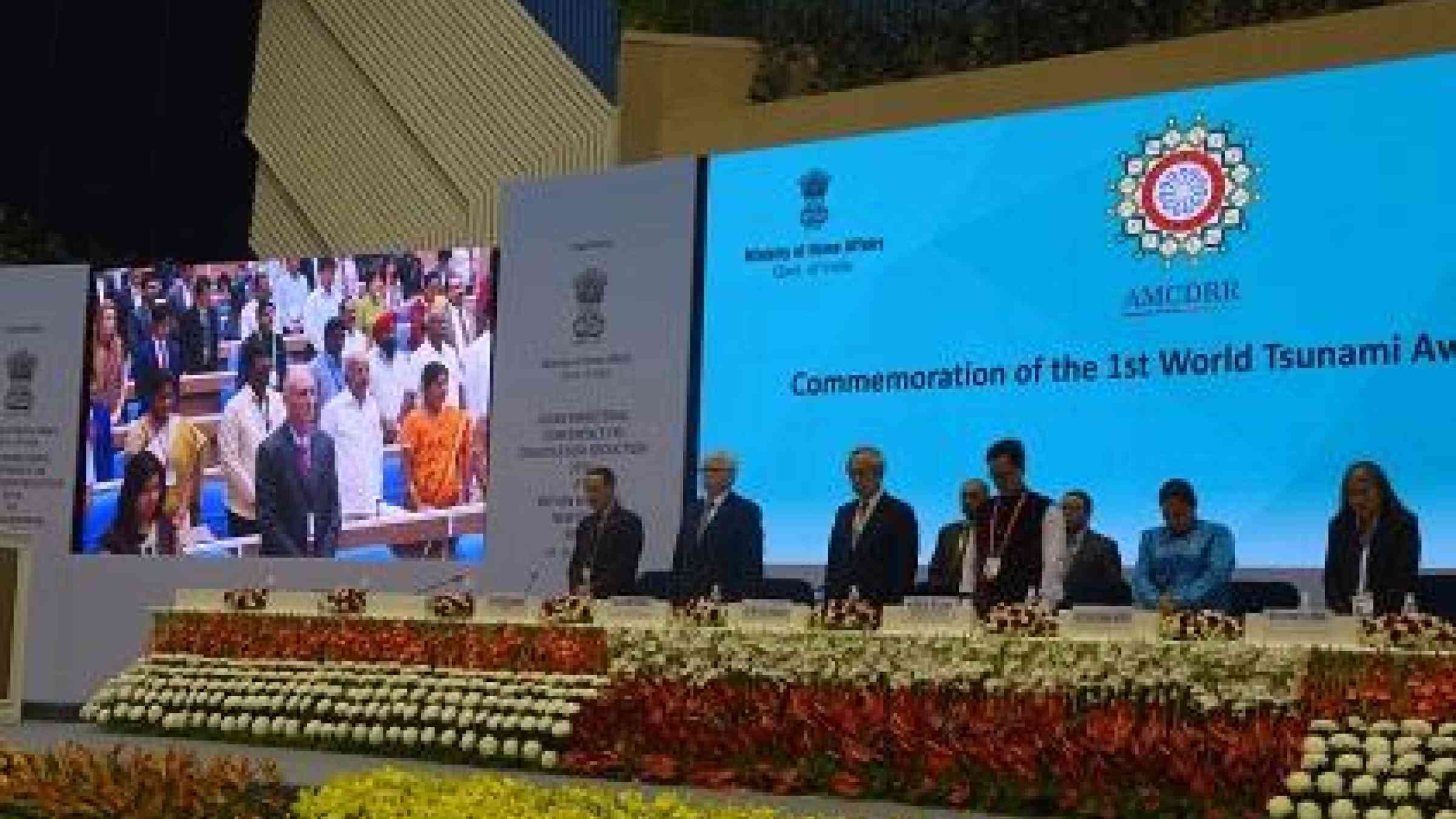Tsunami dead remembered

Mr. Robert Glasser, UNISDR Chief, (left) led a moment's silence today at the World Tsunami Awareness Day Commemoration on the final day of the Asian Ministerial Conference on Disaster Risk Reduction
NEW DELHI, 5 November 2016 - The UN Secretary-General’s Special Representative for Disaster Risk Reduction, Mr. Robert Glasser, initiated a minute’s silence today in remembrance of all those who have lost their lives in tsunamis as the first World Tsunami Awareness Day was commemorated on the final day of the Asian Ministerial Conference for Disaster Risk Reduction.
The theme of the tsunami day is “Live to Tell”, creating a link back to the 13 October International Day for Disaster Reduction which focussed on reducing disaster mortality, and the focus is on promoting effective education and evacuation drills.
Mr. Glasser began a panel discussion by recalling that the day was chosen to honour the efforts of a Japanese local leader, Goryo Hamaguchi, who set fire to his rice sheaves to warn people that a tsunami was coming following an earthquake on 5 November 1854.
“In total, 16 major tsunamis killed 250,900 people in 21 countries between 1996 and 2015. Tsunamis know no borders, making international cooperation key for deeper political and public understanding of risk reduction measures,” he said.
Mr. Kiren Rijiju, Indian Minister of State for Home Affairs and UNISDR Champion, recalled that the 2004 Indian Ocean tsunami caught the country unprepared and that 10,749 people lost their lives.
He said it was a watershed in the history of disaster management in India, leading to the Disaster Management Act of 2005 which provided the legislative framework for the country’s first National Disaster Management Plan launched by Prime Minister Narendra Modi this year and based on the priorities for action of the Sendai Framework for Disaster Risk Reduction.
Mr. Kenji Hiramatsu, the Ambassador of Japan, said it was encouraging to hear so many speakers referring to the story of Goryo Himaguchi which highlighted three key issues, the importance of early warning, traditional knowledge about tsunamis and the need to invest in protective measures which the leader did in his village after the tsunami.
He stressed the importance of raising awareness among schoolchildren. Japan is organising a High School Summit on tsunami risk for children from all over the world to mark the day.
Ms. Regina Prosper of the Government of the Seychelles, said it was time for people to stop seeing tsunamis as far-off events, as few coastal regions were entirely safe. Continuous training and evacuation plans were vital to efforts to reduce loss of life.
Mr. Vladimir Ryabinin, Executive Secretary of the Intergovernmental Oceanographic Commission (IOC) and Assistant Director General of UNESCO, said that the IOC started to build and coordinate the first tsunami warning system in the Pacific in 1965. Repeated calls by the IOC to put other systems in place were not heard until after the 2004 Indian Ocean tsunami. Now there are three other tsunami warning systems covering the Indian Ocean, the Caribbean, and the North East Atlantic, Mediterranean and Black Seas.
He observed that tsunamis are infrequent and it is human nature to forget past tragedies but it was of absolute importance that the warning systems were maintained and kept running. Awareness was key to success especially through education and there were many examples of informed schoolchildren who saved their own lives and those of others.
Dr. Laura Kong of the United States, Director of the International Tsunami Information Center, UNESCO/IOC-NOAA partnership, said that since 1975 there have been 43 deadly tsunamis with nearly 70% in the Pacific and its marginal areas but a total of 249 deadly tsunamis, 87% generated by earthquakes, had been recorded since 1610 BC.
“Tsunamis are blind to political borders, wreaking havoc locally and also crossing ocean basins with deadly waves that can reach 40 metres high and flood six kilometres inland,” she said.
Dr. Kong said tsunami risk awareness needs to be embedded in the education curriculum noting that “if we invest in earthquake awareness and preparedness, we are also building tsunami awareness. After we Drop, Cover and Hold till the shaking stops, we should know that a tsunami may be coming, and evacuate immediately to a safe place.”
Over 600 people attended the commemoration in New Delhi.
Explore further
Also featured on
Is this page useful?
Yes No Report an issue on this pageThank you. If you have 2 minutes, we would benefit from additional feedback (link opens in a new window).